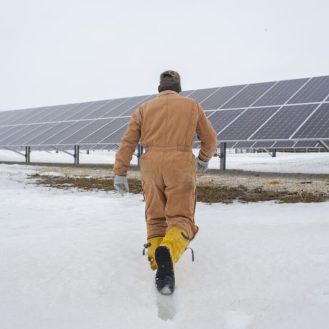Midwesterners know Lake Michigan for its crystal-clear water, sandy dune beaches and stunning views. But the lake’s southwest corner has a legacy of pollution, too. Steel mills, oil refineries and other heavy industrial facilities dot the shoreline from Chicago over to the Michigan border.
Now, a burgeoning industry is hoping to accelerate the clean energy transition in the region with a new “hydrogen hub,” or a network of hydrogen producers, consumers and transportation infrastructure meant to accelerate the use of hydrogen as a fuel source in the U.S.
There, a group of corporations and public agencies, known collectively as the Midwest Alliance for Clean Hydrogen, or MachH2, hopes to take advantage of new federal funding to build such a hub.
They’ve submitted an application to the Department of Energy in a bid to receive a portion of a $7 billion allotment meant to support up to ten hubs nationwide, made available by the 2021 Infrastructure Investment and Jobs Act. The DOE is expected to announce the recipients of the funding before the end of the year.
In theory, the hydrogen hub could provide a huge opportunity for the area in the form of new jobs and a decarbonization strategy for the region’s highly polluting steel industry. But environmental advocates in the area say they haven’t seen sufficient information from MachH2 or the DOE to show that the hydrogen hub will have a net benefit for the climate or the region’s residents.
“Environmental, labor and justice community leaders must be included in these publicly funded, multibillion dollar, industry led proposals for hydrogen,” said Chris Chyung, executive director of the Indiana Conservation Voters, an environmental advocacy group. “That’s a simple thing that we think that [MachH2] should be able to meet.”
A “Game Changer”
Environmental advocates in the region hope the proposed hub can offer solutions to environmental injustices residents face. Indiana, for example, ranked last in an analysis earlier this year that evaluated environmental justice efforts in the Midwest, and residents on the state’s shoreline have dealt with higher-than-average air pollution and water contamination for decades. Between the Illinois border and Gary, Indiana, alone (about a 15-minute drive) there are ten current or proposed Superfund sites, as well.
The influx of federal money for clean energy projects could be a “game changer” for environmental justice in the region, said Chyung—but that all depends on who benefits most from the proposed hydrogen hub.
“We can really turn the tide here. I really don’t want us as a region to squander the ability to transition to clean sources and to be a technological leader in things like clean steel and clean hydrogen, nationally,” he said.
He and other advocates are particularly focused on one application for the hydrogen fuel: using it to make steel. Traditional steelmaking uses petcoke (a derivative of oil refining) and fossil-fuel power, making the process particularly emissions-intensive and polluting. Steelmaking is hard to electrify, but using hydrogen can drastically reduce the carbon footprint of the industry and could have an incredible impact on air pollution faced by nearby communities, said Chyung.
“We want to really draw the focus away from these pie-in-the-sky applications,” said Chyung. “The hydrogen hub proposal needs to be laser focused on steel, because it’s so dirty and hard to decarbonize. To ignore steel would really be such a missed opportunity.”
Neil Banwart, MachH2’s chief integration officer, said the coalition could not share names of particular users (also known as offtakers) for the hydrogen that will be produced, but that the hydrogen could be used for multiple purposes, including heavy duty trucking, rail transport, chemical fertilizer production, glass manufacturing, and decarbonizing the steel industry. “Steel is absolutely an offtake that we’re really excited about,” he said.
In June, Indiana Conservation Voters and 14 other environmental groups sent a letter to MachH2 and the DOE, asking for greater transparency and more opportunities for community input in the planning process. “It is unacceptable for out-of-state interest groups and their consultants to shut out local environmental, racial justice and faith community leaders from these important discussions that can make or break Indiana’s industrial and clean energy future,” the authors wrote.
Banwart said MachH2’s hands are tied, and that it can’t reveal more specific information about the plans or locations of the facilities until the DOE selects which project will receive funding. “We’re still part of a very competitive process, and so there’s a limit to what we can share,” he said. “Our commitment is to be as transparent as possible. After the DOE makes their award announcements, we’ll move right into the negotiation phase, and we’ll continue the dialogue… we really look forward to sharing more details.”
Members of Indiana Conservation Voters and other environmental organizations have met with Banwart once, but said the conversation did not provide much additional detail. “Unfortunately, it’s kind of a black box at this moment in time,” said Ben Inskeep, program director for the Indiana-based environmental and consumer advocacy group Citizens Action Coalition.
Banwart also said MachH2 is committed to environmental justice and the Biden Administration’s Justice40 Initiative, which aims to ensure that 40 percent of the benefits of certain federal investments flow to communities dealing with environmental injustices.
Down to the Details
In addition to environmental justice impacts, the details of MachH2’s proposal could have huge implications for the project’s climate benefits, too. Hydrogen can be produced many different ways, and different types of hydrogen can have wildly different emissions footprints.
Types of hydrogen are often referred to by corresponding colors, depending on how the hydrogen is sourced and what type of energy powers the process. Green hydrogen, for example, refers to hydrogen sources from water, with the process powered by renewable energy. Producing blue hydrogen uses methane (a main component of natural gas) as the source, and creates carbon dioxide as a by-product. With blue hydrogen, the company captures and sequesters the carbon dioxide by-product.
Virtually all the hydrogen in the US is sourced from fossil fuels, such as natural gas, according to the DOE. MachH2 plans to source its hydrogen in a variety of ways, including from natural gas. Both green and blue hydrogen are part of the proposal, and carbon capture and sequestration will also be included, said Banwart.
According to Mark Jacobson, a professor of environmental engineering at Stanford University, blue hydrogen production isn’t much of a climate solution at all. The carbon capture process, he said, is highly energy-intensive, and since blue hydrogen production relies on natural gas as a hydrogen source, it has a high likelihood of increasing fossil fuel infrastructure, air pollution and planet-warming emissions.
Environmental advocates are also concerned that a new hydrogen hub could use clean energy currently in use by underserved residents, without adding new clean energy to the grid. “We can’t just let the industrial user gobble up all of the clean energy,” said Chyung.
MachH2 expects to source its energy from a combination of nuclear, wind and solar energy, according to Banwart.
Looming Federal Guidance
In addition to money from the DOE, hydrogen entrepreneurs benefit from a tax credit included in the Inflation Reduction Act passed last year. The IRA offers producers up to $3 per kilogram of hydrogen produced, with more money available to companies able to prove that their hydrogen has a low emissions impact.
However, the Biden Administration has yet to release guidelines outlining how that emissions impact will be calculated. What those guidelines say could have big impacts on the climate, according to environmental advocates.
Keep Environmental Journalism Alive
ICN provides award-winning climate coverage free of charge and advertising. We rely on donations from readers like you to keep going.
For example, a group of environmental advocates have been pushing the Treasury Department, which administers the tax credits, to implement three main guidelines: ensuring hydrogen projects prove that the energy they’re sourcing is renewable and requiring accurate accounting of the climate impacts of both hydrogen leaks and the natural gas used in the process.
“It’s a really generous tax credit, it’s incredibly beneficial, and really will do a lot to accelerate and to incentivize production of hydrogen,” said Beth Trask, an energy transition expert at the Environmental Defense Fund. “But if you’re going to get those tax credits, you really need to be able to show that you are generating those climate benefits per kilogram of hydrogen produced. That’s imperative.”
Weak guidelines could cause the federal government to spend billions of dollars subsidizing projects that lead to a net increase of greenhouse gas emissions, a coalition of environmental organizations wrote in a letter to the Treasury earlier this year.
“If it’s implemented in a bad way, it can mean a lot of companies will be getting really rich off of making dirty hydrogen that’s exacerbating environmental injustices,” said Inskeep.
The DOE is expected to announce whether MachH2 will receive federal funding sometime this fall. In the meantime, northwest Indiana residents hope they’ll get a chance to evaluate MachH2’s plans in full. “You fear for the worst state like Indiana, which has historically been captured by fossil fuel interests,” said Inskeep.









